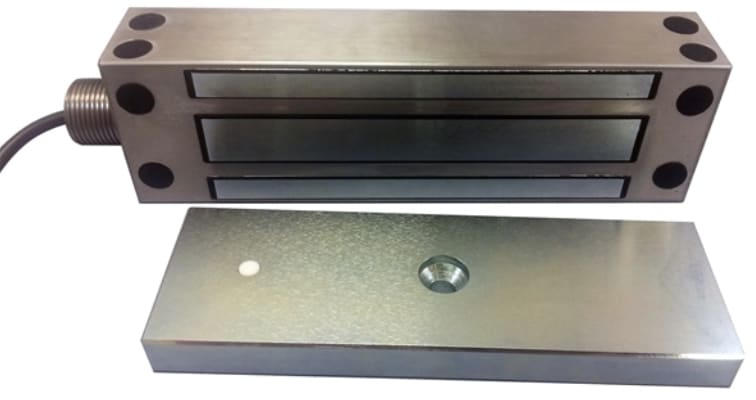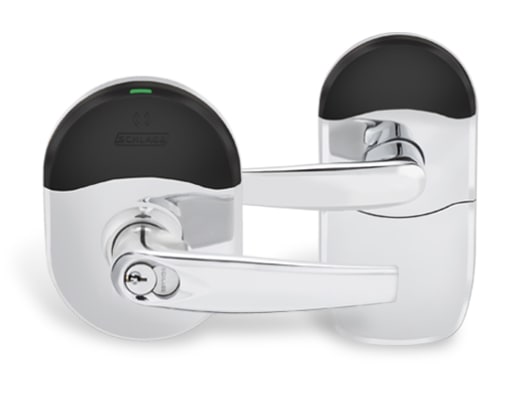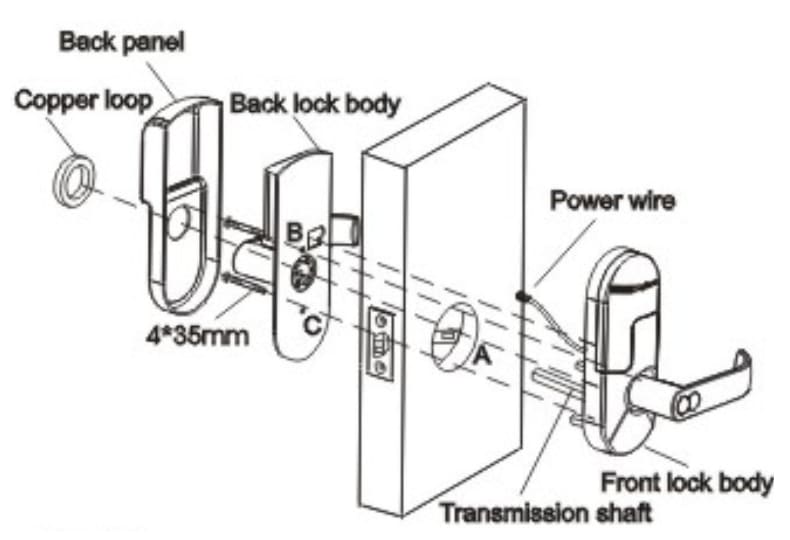So you’ve recently moved into a new office, or you’re looking to renovate, and you find yourself having to decide what type of commercial door lock to get. You could opt for the tried and true standard, wired types of commercial locks. These encompass fail-safe locks like magnetic locks or fail-secure locks like electric strikes. To read more about the ecosystem of common commercial door locks, and how they integrate with Kisi, refer to this article on the Kisi blog.

Example of a classic wired maglock
What are smart locks?
In this article, we’ll be looking at a new type of electronic commercial door lock emerging on the market: WiFi-enabled smart door locks. Here is an example of a popular one: the Allegion NDE smart lock.

An emerging trend in the access control market is the total bucking of standard key-lock methods in favor of Bluetooth and NFC-enabled door readers. Indeed, Kisi is a strong proponent of this. WiFi door locks appear in the same vein, offering a slew of new solutions for the modern homeowner or office administrator hoping to rid themselves of physical keys and all the problems associated with them.
Why are smart locks important?
Studies and surveys show that half of Americans lose their keys at least once per week, and the total wasted time costs them $5,500 over the course of their life. The solution appears straightforward — make the switch to a keyless system! Now, it’s important to note that switching to a smart lock will not make your door physically stronger because the hunk of metal securing it to the frame will likely remain the same; however, it will give you a greater measure of control. Easily granting and revoking access will allow you to monitor who’s coming and going — ultimately making your home more secure. There are many factors to consider here before taking the plunge, and we’ll guide you through the decision-making process.
Are you installing in a home or an office?
The first aspect to consider is whether you’re looking to install at a home or in an office. While there is certainly overlap in terms of available offerings, the needs, and available resources, will be different.
Smart Home Inter-connectivity
The most exciting aspect of smart locks for homes are integrations with any one of the smart home systems available today, the most popular being Apple’s HomeKit, Amazon Alexa, and Google Home. Full home automation is an incredibly hot topic today, with nearly every electronic aspect of the home being incorporated into a unified ecosystem. Through voice commands or a display interface, the hub controls everything from speakers, doorbells, and lightbulbs, to plugs, temperature sensors, and video cameras. Smart locks are merely another fine addition to the collection. If you’re buying a smart lock for your home, you want to make sure that whichever one you’re considering is compatible with the smart hub that you currently work with, or with any that you might want to get in the future.
Office Smart Locks: Different Protocols
Beyond that, what specific protocol you want should be a factor, and this helps us segue into the office lock section. There are three main options here: Bluetooth, Z-wave, or WiFi. All three are wireless protocols that can effectively communicate with other enabled devices.
WiFi Protocol
WiFi, the most famous of the bunch, is the most powerful in terms of bandwidth capability; it has unlimited range given adequate network connectivity. This means you can communicate with your lock from anywhere in the world; however, it has the marked disadvantage of requiring a lot of power, so unless you want to be replacing the batteries on a monthly basis, you’ll need to wire in the power, which in our opinion somewhat defeats the purpose.
Z-Waves
Z-waves are a protocol very similar to WiFi, in terms of bandwidth and range, with the added benefit that they are optimized for low battery usage, meaning that you’ll need to replace batteries much less often. However, they do have the drawback that they cannot communicate directly with your network to transmit information: They require a Z-wave hub to act as an intermediary (you cannot talk to them from your phone without the hub). The good news is that most smart home hubs can interpret Z-waves, but it’s an added consideration.
Bluetooth
Bluetooth is a bit less powerful, in terms of network load, although it will be more than sufficient for smart locks. The one drawback is its range, which is usually limited to around 150 feet or less, meaning that you will need to be in its vicinity to unlock the door (you will not be able to unlock from, say, across the city). Beyond that, it is energetically efficient — requiring very little upkeep. Your phone actually speaks the Bluetooth language, meaning that you can communicate with it without needing any sort of interface. This is particularly cool if you don’t much enjoy having to navigate confusing and unintuitive app interfaces, and simply want to, for instance, tap your phone to the lock to get access.
Case Study on Bluetooth Smart Lock
For a case study, let’s take a look at a specific lock with this capability: the Schlage NDE series lock. This lock, besides its aesthetic appeal, offers proximity and smart readers; this means that you’d be able to unlock it using an NFC-enabled smart card. This is convenient, because you can keep it in your wallet and tap it on the reader to unlock the door. An added benefit is that your phone can actually interpret these signals (it has antennas that operate at the same frequency). With the power of platform integrations, such as the one Kisi offers, you can merely tap your phone to the reader to unlock it. This sort of interactivity is the main strength of smart locks; they offer far more modularity and connectivity with all your other networked devices — like smartphones — allowing you to secure your space in a much more intuitive and controllable way.

In this diagram, we can see all aspects of the smart lock, including the wired, electronic part, and the frame and physical lock. These work together to ensure that your door is as secure as can be.
Summary
Wireless locks represent an interesting innovation in the field of access control. They leverage wireless technologies like Bluetooth and NFC to their fullest potential. It’s not always possible to install wiring next to your doors, and it’s generally more difficult and less aesthetically pleasing.
However, you could argue that this is counterbalanced by the need for batteries. It could be said that the true innovation will come with wireless charging at a distance, and not merely the cool new induction charging stations that you see appearing for Apple watches and the like. At that point, you’ll even be able to use your regular access control readers like Kisi, and just charge them at a distance.
While they’re certainly a viable alternative to access control readers, whether they manage to innovate as technology progresses will determine whether or not they’re the true next step in smart physical security.
Save time. Enhance security.
Modernize your access control with remote management and useful integrations.
Continue learning

